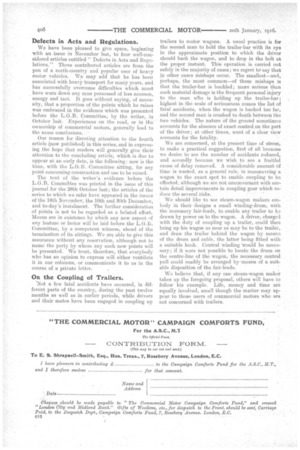On the Coupling of Trailers.
Page 2

If you've noticed an error in this article please click here to report it so we can fix it.
Not a few fatal accidents have occurred, in different parts of the country, during the past twelve months as well as in earlier periods, while drivers and their mates have been engaged in coupling up trailers to motor wagons. A usual practice is for the second man to hold the trailer-bar with its eye in the approximate position to which the driver should back the wagon, and to drop in the bolt at the proper instant. This operation is carried out safely in the majority of cases; we regret tosay that in other cases mishaps occur. The smallest—and, perhaps, the most common—of these mishaps is that the trailer-bar is buckled; more serious than such material damage is the frequent personal injury to the man who is holding up the trailer-bar; highest in the scale of seriousness comes the list of fatal accidents, when the wagon is backed too far, and the second man is crushed to death between the two vehicles. The nature of the ground sometimes accounts for the absence of exact control on the part of the driver; at other times, want of a clear view accounts for the fatality.
We are concerned, at the present time of stress, to make a practical suggestion, first of all because we desire to see the number of accidents reduced, and secondly because we wish to see a fruitful cause of delay removed. A considerable amount of time is wasted, as a general rule, in manceuvring a wagon to the exact spot to enable coupling to be effected, although we are not unconversant with certain detail improvements in coupling gear which reduce the several risks.
We should like to ace steam-wagon makers embody in their designs a small winding-drum, with the necessary fair-leads, to enable any trailer to 13? drawn by power on to the wagon. A driver, charged with the duty of coupling up a trailer, could then bring up his wagon as near as may be to the trailer, and draw the trailer behind the wagon by means of the drum and cable, the ,latter being fitted with a suitable hook. Central winding 'would be necessary; if it were not possible to locate the drum on the centre-line of the wagon, the necessary central pull could readily be arranged bymeans of a suitable disposition of the fair-leads.
We believe that, if any one steam-wagon maker takes up the foregoing proposal, others will have to follow his example. Life, money and time are equally involved, small though the matter may appear to those users of commercial motors who are not concerned with trailers.




















